MARIANI’S
Virtual
Gourmet
November
16, 2014
NEWSLETTER
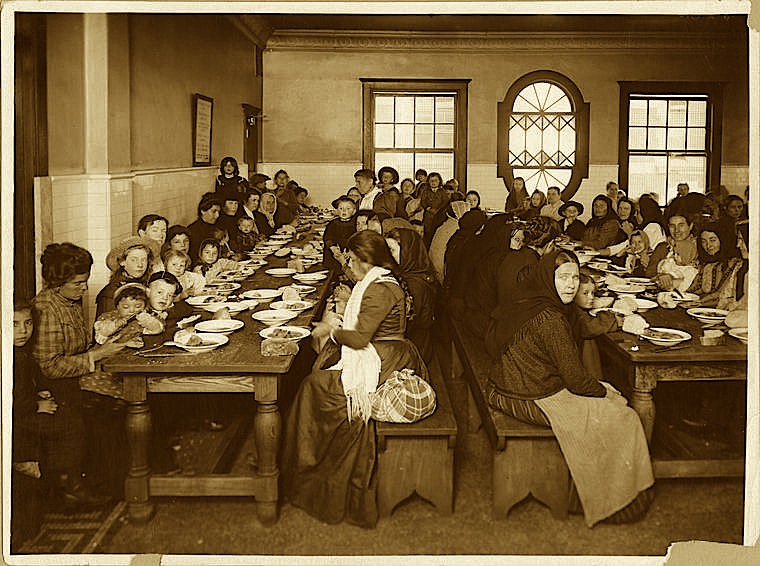
Immigrants at Ellis Island, NYC (1902), where the sign on the wall,
written in several languages, said 'NO CHARGE FOR MEALS HERE'
IN THIS ISSUE
BALTIMORE RENAISSANCE
By John Mariani
NEW YORK CORNER
SAN PIETRO and CIRCO
By John Mariani
NOTES FROM THE WINE CELLAR
WHAT I'M DRINKING NOW
By John Mariani
❖❖❖
BALTIMORE RENAISSANCE
IN FULL SWING
By John Mariani

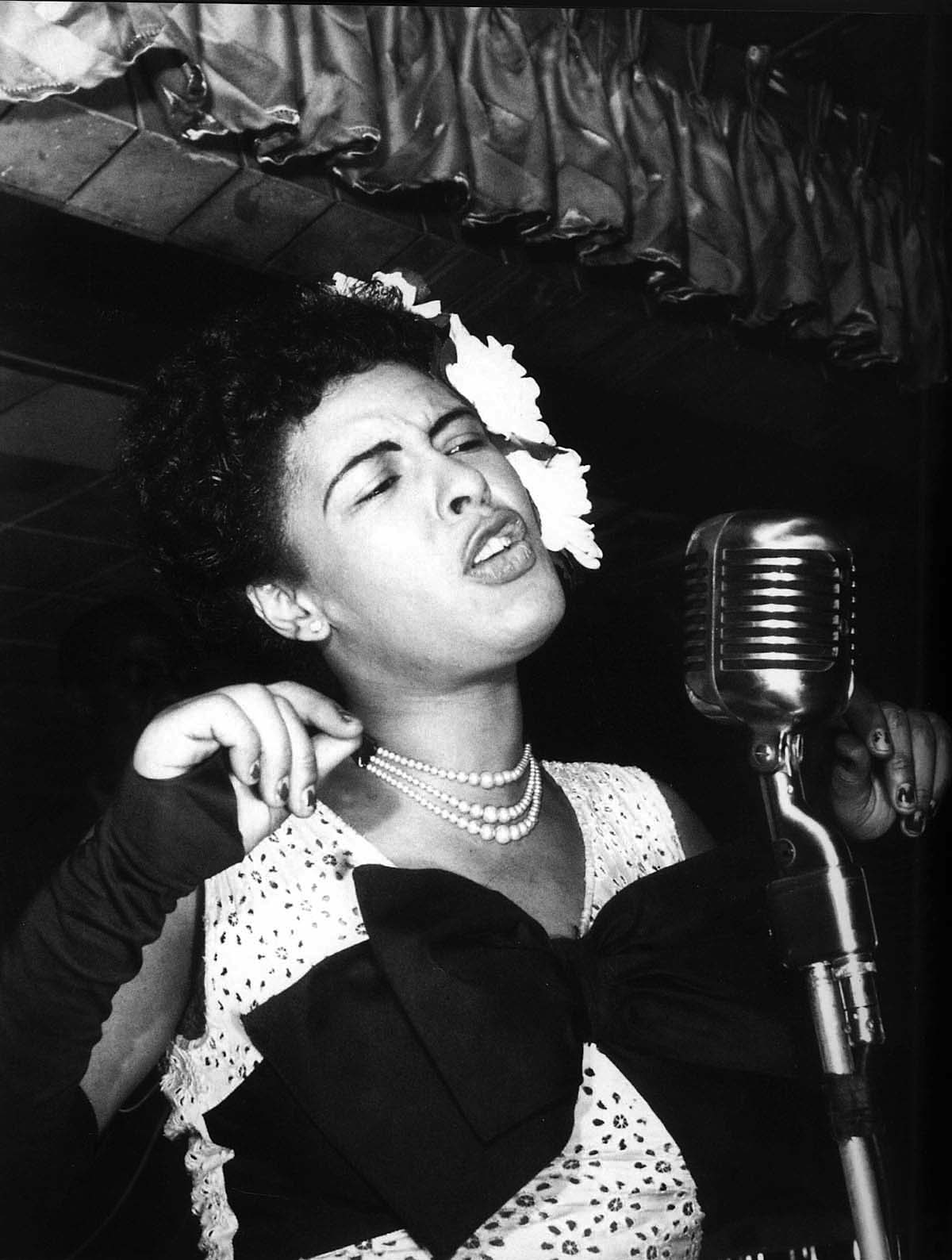 The city’s native sons and daughters
include Edgar Allan Poe (who has a museum in town
that rarely seems to be open), “Eubie” Blake and
Billy Holiday (left),
Babe Ruth, and director Barry Levinson, who’s shot
several movies in his cherished hometown, including
“Diner” (1982) in the photo below,
The city’s native sons and daughters
include Edgar Allan Poe (who has a museum in town
that rarely seems to be open), “Eubie” Blake and
Billy Holiday (left),
Babe Ruth, and director Barry Levinson, who’s shot
several movies in his cherished hometown, including
“Diner” (1982) in the photo below, 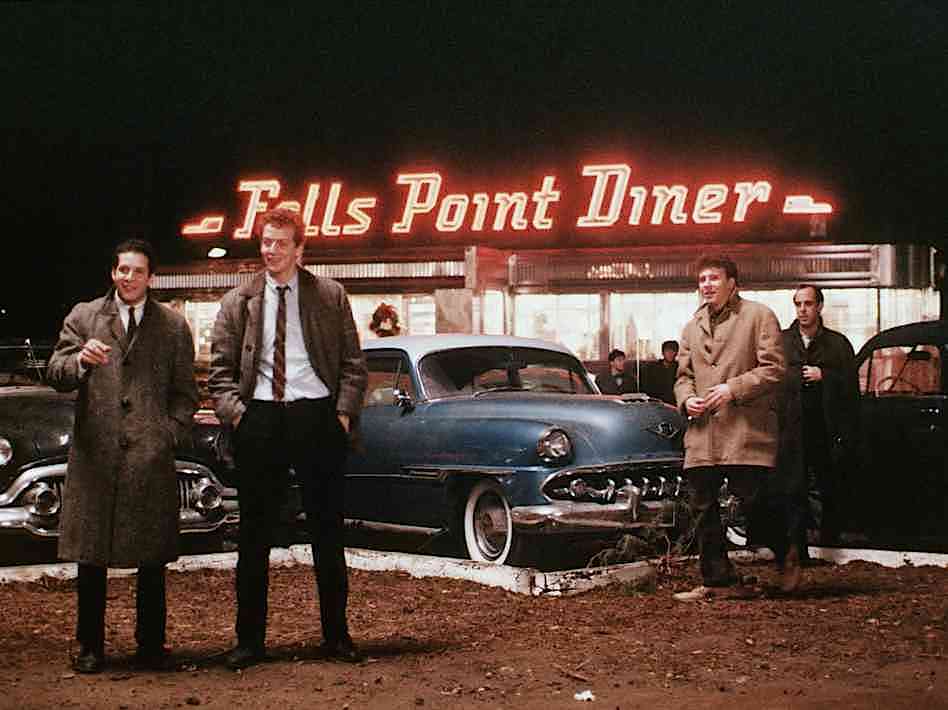 which made the Fells Point
Diner a pop culture tourist attraction. (Ironically,
there never was a diner on that location; Levinson
had one moved there, then moved it back. Today the
location is a brick condo.)
which made the Fells Point
Diner a pop culture tourist attraction. (Ironically,
there never was a diner on that location; Levinson
had one moved there, then moved it back. Today the
location is a brick condo.)
Baltimore’s schools, like Johns
Hopkins University and Loyola have enviable national
reputations, as do the Walters Art Museum
and the Baltimore
Museum of Art, this year celebrating its 100th
anniversary. Baltimore’s major sports teams—the
Orioles and Ravens—draw crowds from all over the
Mid-Atlantic region.
It’s also the country’s leading producer of
straw hats. Who
knew?
The development in the 1970s of
the Inner Harbor, which includes Harborplace, most
certainly brought light, safety and tourism to a
once derelict part of the city. Sadly, though,
instead of featuring the food of Chesapeake Bay,
Harborplace has become nothing more than yet another
shopping center,
with all the usual national brands and restaurants,
from Hooter’s to Bubba Gump Shrimp Co.
Baltimore
is actually an easy one- or two-day visit by train
from NYC, Philadelphia, Wilmington and DC.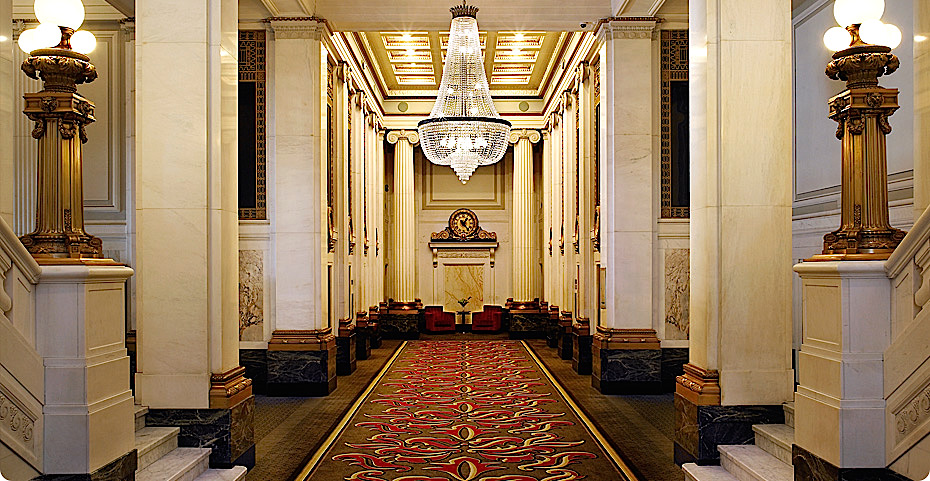 On my
last trip I stayed at the Hotel Monaco
(right),
which appears to be a stately old grande dame of a
hotel, but is actually a magnificent conversion of
the historic and majestic B&O Railroad
headquarters, done in a stunning Beaux Arts
architecture (it’s well worth reading the building’s
history, posted on the mezzanine). With only 202
rooms, there is plenty of space for bed and bath,
including bunk beds for families, complimentary
wi-fi,
morning coffee and tea, a hosted evening wine hour,
and free use of public bikes.
On my
last trip I stayed at the Hotel Monaco
(right),
which appears to be a stately old grande dame of a
hotel, but is actually a magnificent conversion of
the historic and majestic B&O Railroad
headquarters, done in a stunning Beaux Arts
architecture (it’s well worth reading the building’s
history, posted on the mezzanine). With only 202
rooms, there is plenty of space for bed and bath,
including bunk beds for families, complimentary
wi-fi,
morning coffee and tea, a hosted evening wine hour,
and free use of public bikes.
Baltimore’s restaurants are as
varied as any big city’s right now, so avoiding the
banal offerings in Harborplace is easy. The city’s
Little Italy neighborhood is within walking
distance, with the usual Italian-American style
restaurants, all serving pretty much the same menu,
though Aldo’s is
several cuts above most, and actor Chazz Palminteri
runs a first-rate Bronx-style pizzeria under his
name.
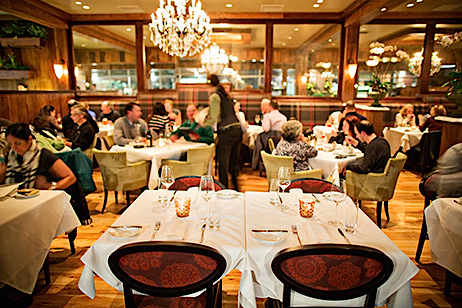 Right
on the water is Fleetstreet
Kitchen (1012 Fleet Street;
410-244-5830), set
between Little Italy and Harbor East. Modern
and beautifully lighted, the establishment has a
convivial bar and tavern room, with plenty of space
between tables. In
the main dining room (left) plaid banquettes,
chandeliers, ceiling lights, and splashes of flowers
make it one of the city’s most romantic spots to
dine, helped along by a wide-ranging wine list. The Baltimore Sun
named it one of the best restaurants of 2014.
Right
on the water is Fleetstreet
Kitchen (1012 Fleet Street;
410-244-5830), set
between Little Italy and Harbor East. Modern
and beautifully lighted, the establishment has a
convivial bar and tavern room, with plenty of space
between tables. In
the main dining room (left) plaid banquettes,
chandeliers, ceiling lights, and splashes of flowers
make it one of the city’s most romantic spots to
dine, helped along by a wide-ranging wine list. The Baltimore Sun
named it one of the best restaurants of 2014.
Chef Michael Correll delivers unexpected pleasures
like chilled ratatouille soup ($9), with a nicely
spiced piperade of peppers. Ricotta-filled
ravioli ($13) came with a truffle essence, a poached
egg, fennel, brown butter cream and Easter egg
radish—a good but complicated dish whose overkill of
ingredients caused the pasta to cool while all the
rest of the ingredients were added. Two main courses
were outstanding—a perfectly seared and juicy
halibut with glazed 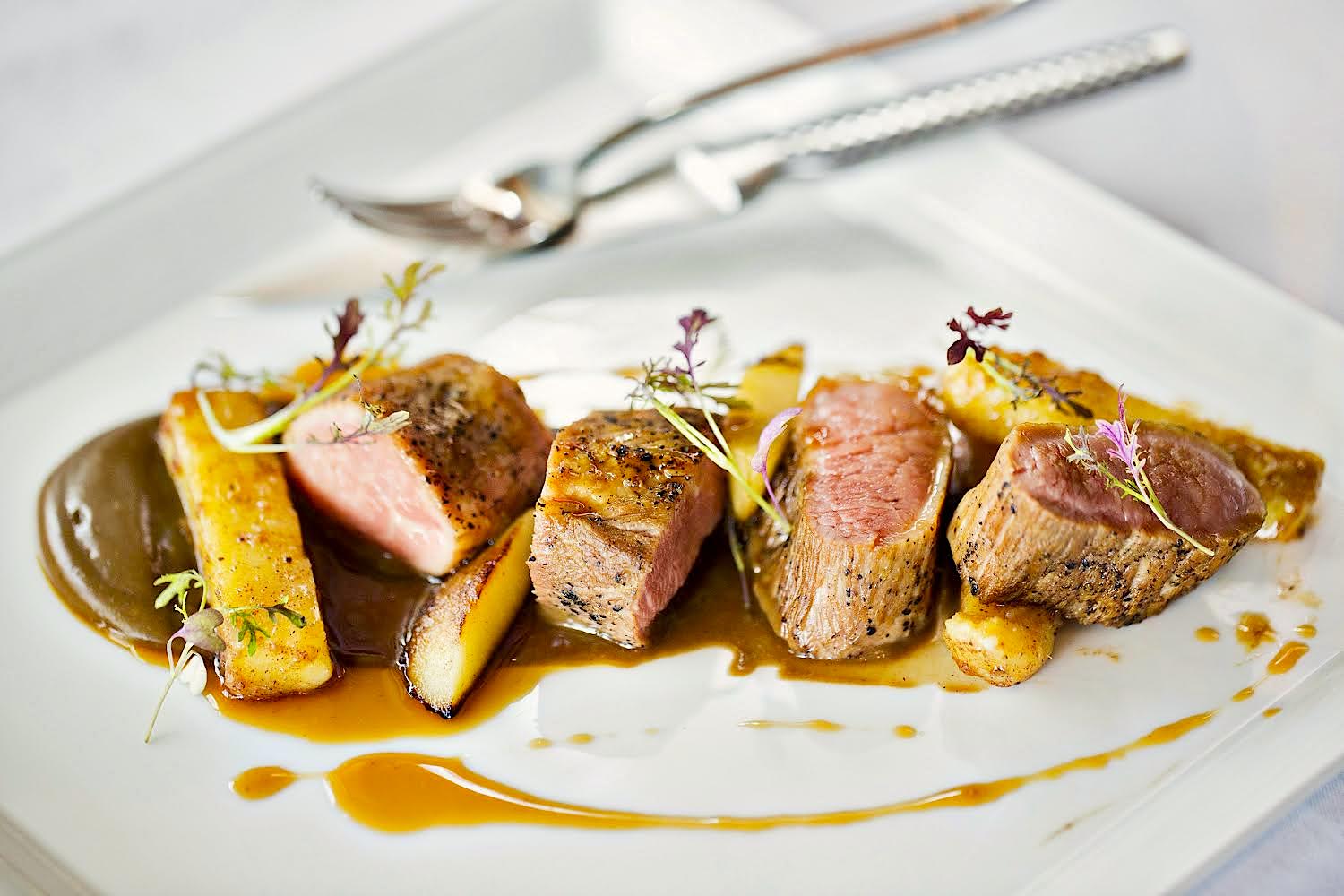 baby
carrots, the tang of lemon, the crunch of hazelnuts
and sweet carrot butter ($30); and roasted pork,
impeccably cooked to pink, with a nice crust on the
outside, served with charred radicchio, green beans
and sautéed leeks ($30).
baby
carrots, the tang of lemon, the crunch of hazelnuts
and sweet carrot butter ($30); and roasted pork,
impeccably cooked to pink, with a nice crust on the
outside, served with charred radicchio, green beans
and sautéed leeks ($30).
There’s a four-course dinner menu at $65,
whereby you choose whatever you like from the menu;
a chef’s tasting menu of seven courses ($85), and a
vegetarian tasting menu ($65); each may be paired
with wines for a supplement.
There’s no let-up in proportions
with the wonderful desserts like honeycrisp apple
napoleon with cardomon-flecked cream, almond-pecan
granola, and apple sorbet ($9), or the frozen
pumpkin mousse with pumpkin seed toffee pomegranate
($8).
The wine list is one of the best
in town, but pricey, with too few whites under $50 and top
heavy with reds above $100, though they are of good
value.
Open for dinner nightly.
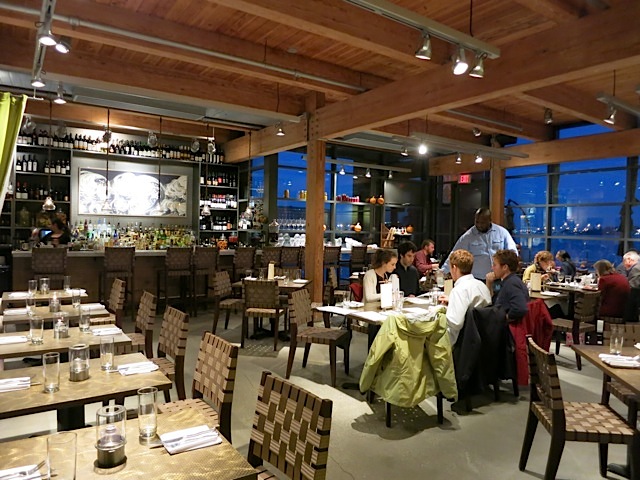 The
appropriately named Waterfront
Kitchen (1417
Thames Street; 443-681-5310 ) is a
handsome, wide 78-seat restaurant that sets just the
right balance of sophistication and casual chic. A
canny use of rustic and polished woods along with
heavy draperies and woven fabric chairs might only
be improved by having soft tablecloths rather than
hard surfaces, but the view at twilight of the
harbor has enormous charm seen through 35-foot-tall
glass windows.
The
appropriately named Waterfront
Kitchen (1417
Thames Street; 443-681-5310 ) is a
handsome, wide 78-seat restaurant that sets just the
right balance of sophistication and casual chic. A
canny use of rustic and polished woods along with
heavy draperies and woven fabric chairs might only
be improved by having soft tablecloths rather than
hard surfaces, but the view at twilight of the
harbor has enormous charm seen through 35-foot-tall
glass windows.
The restaurant also has a
“mission statement,” which usually means fatuous
seriousness, but in fact that mission is to support
urban gardening for students (the
kitchen has its own garden and greenhouse), and they
are involved with a program to hire disadvantaged
Baltimoreans.
The ebullient chef
Jerry Pellegrino is a man of good appetite, as you can tell by the generosity on his
plates and the proud emphasis on American tradition. He turns out food that has vigorous
flavor and genuine nuance in dishes like pan-seared
foie gras with a red wine and fruit compote and
spiced nuts ($16) and duck leg confit with plum
compote and greens ($12); entrees with heft, like
braised lamb shank with crispy smashed potatoes
($32) and pan-seared scallops with roasted pumpkin,
crispy polenta and pea tendrils ($30). There is
also an array of housemade charcuterie ($9-$11).
can tell by the generosity on his
plates and the proud emphasis on American tradition. He turns out food that has vigorous
flavor and genuine nuance in dishes like pan-seared
foie gras with a red wine and fruit compote and
spiced nuts ($16) and duck leg confit with plum
compote and greens ($12); entrees with heft, like
braised lamb shank with crispy smashed potatoes
($32) and pan-seared scallops with roasted pumpkin,
crispy polenta and pea tendrils ($30). There is
also an array of housemade charcuterie ($9-$11).
As at Fleet Street Kitchen, the 600-label
wine list at Waterfront Kitchen seems weighted
toward higher priced bottlings, but they are of high
quality too.
Lunch and dinner Tues – Sun.
The odd name of Parts and
Labor (2600
North Howard Street; 443-873-8887) derives
directly from its having recently been a car garage
of the same name, and the long lines, doors and wide
space of the dining room give it a proletarian
grandeur that has been packing people in as the
city’s 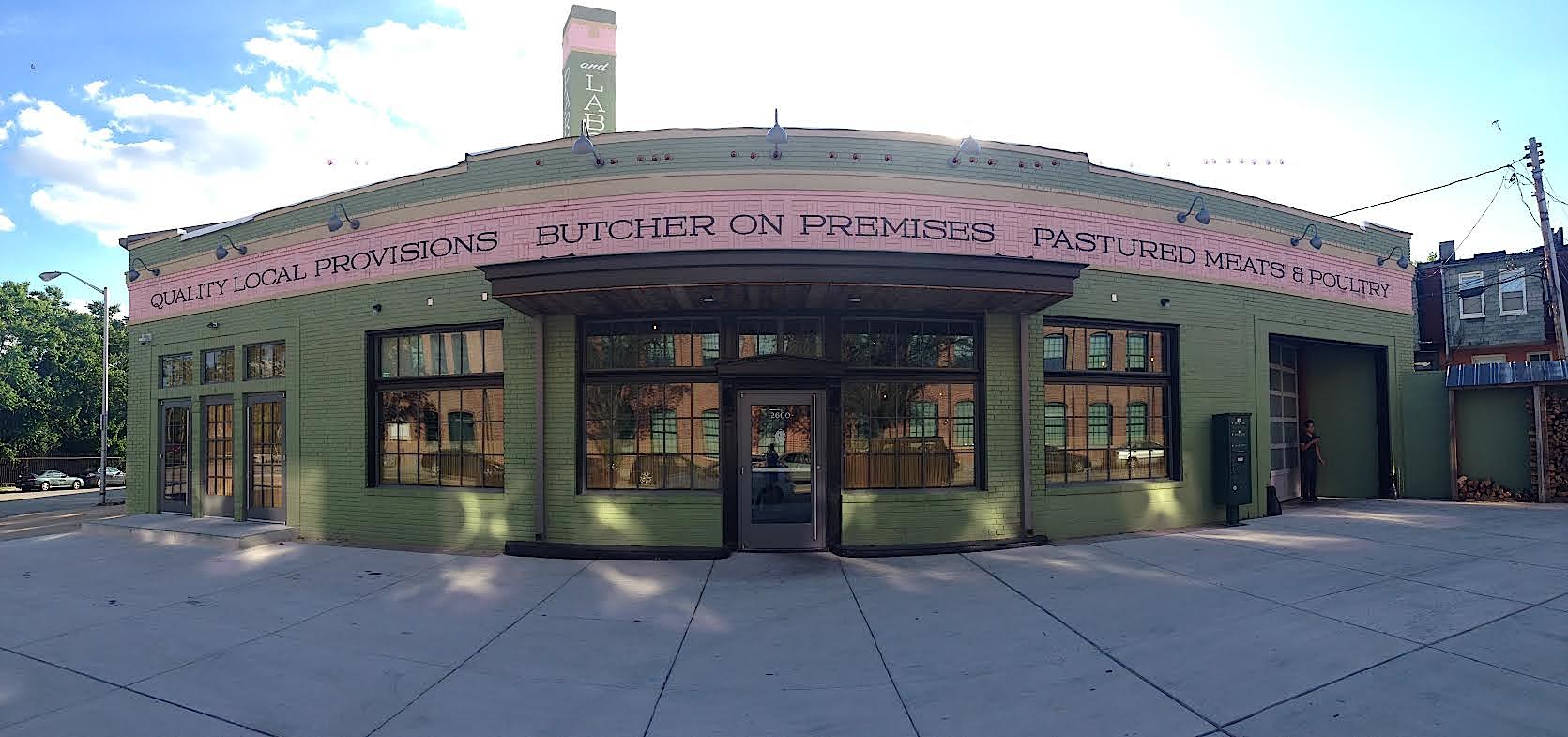 new hot spot
since opening last spring. The slowly
gentrifying neighborhood has a ways to go before it
loses its edginess, but apparently that’s part of
the restaurant’s inherent cool. Owner Spike Gjerde
also runs Woodberry Kitchen in town, with a butcher
shop right on the premises of his new place. There
hang beef carcasses, dry aging on the walls in order
to supply Gjerde’s restaurants while allowing him to
sell retail to the public.
new hot spot
since opening last spring. The slowly
gentrifying neighborhood has a ways to go before it
loses its edginess, but apparently that’s part of
the restaurant’s inherent cool. Owner Spike Gjerde
also runs Woodberry Kitchen in town, with a butcher
shop right on the premises of his new place. There
hang beef carcasses, dry aging on the walls in order
to supply Gjerde’s restaurants while allowing him to
sell retail to the public.
Inside the stark, deafeningly
loud dining area is a 10-foot-high soapstone hearth
fireplace where all that meat is roasted, grilled
and turned on a rotisserie, so the aromas are enough
to alert everyone coming through the door just what
they’re in for. Executive chef and butcher George
Marsh offers a short menu that changes all the time,
so you might find the cuts of meat changing—he
favors the less known, like bavette—so the
superb charcuterie served here may one night include
kielbasa, ham hocks, and wursts befitting
Baltimore’s eastern European immigrant food culture,
on another evening whatever is fresh from the
butcher. There
are also salted meats, including a coriander
flavored mortadella.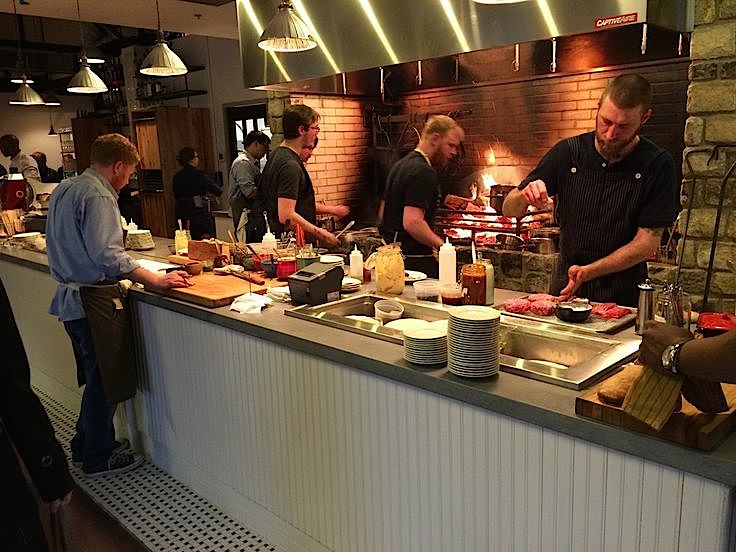
Offal is the pride of the
kitchen, so cuts like pig liver, brains, sweetbreads
and blood sausage show how every scrap of meat is
utilized. There
are also a few seafood items, and most of the first
courses are vegetables, like grilled broccolini with
pecorino, sesame, and fried egg ($13). Portions of
meat are deliberately on the modest size, and are
priced accordingly, like a six-ounce tenderloin at
$18. But there are also “Large Bastard” platters for
tables of three or more that include a 45-ounce côte
de boeuf with potatoes ($100), ten pieces of fried
chicken with mashed potatoes, corn and collards
($75), and braised veal shank ($75).
The food comes out when it’s
ready, so don’t expect three timed courses, though
the wait won't be very long in any case.
 Now about
that dry-aged meat: Marsh proudly buys grass-fed
beef only, for reasons that range from
sustainability to healthfulness, but truth be told,
you are never going to get the marbled inner
muscular fat and sweet flavor from grass-fed beef
that you would from animals raised, or at least
finished, on corn. As a result, the hamburger that
was so highly recommended was actually a bit bland,
and the steak lacked that richness I seek at a
beef-centric restaurant. I’d rather go back for more of
the charcuterie and offal, ending off with a dessert
like the banana split doughnut with ice cream, which
must surely have been raised on corn.
Now about
that dry-aged meat: Marsh proudly buys grass-fed
beef only, for reasons that range from
sustainability to healthfulness, but truth be told,
you are never going to get the marbled inner
muscular fat and sweet flavor from grass-fed beef
that you would from animals raised, or at least
finished, on corn. As a result, the hamburger that
was so highly recommended was actually a bit bland,
and the steak lacked that richness I seek at a
beef-centric restaurant. I’d rather go back for more of
the charcuterie and offal, ending off with a dessert
like the banana split doughnut with ice cream, which
must surely have been raised on corn.
The wine list is nothing to speak of—18 reds,
9 whites--but I can rave about the screed of beers
and the huge spirits list here that offers
specialties like Lot 50 Single Copper Pot Still Rye,
Havana Club Añejo rum, and Oban 14 Year Old Scotch.
Open
Tues-Sun. for dinner. Brunch on Sunday.
❖❖❖
SAN FRANCISCO'S ERNIE'S PASSES AWAY AT 92
By John Mariani

When the term “gentleman
restaurateur” is used the figure of Victor Gotti
comes to my mind with a big smile. Gotti, the
co-owner of San Francisco’s famous Ernie’s
Restaurant, died last week in San Francisco at the
age of 92.
With his
brother Roland (on the left in the photo),
Victor made Ernie’s into one of the most heralded
and respected restaurants in 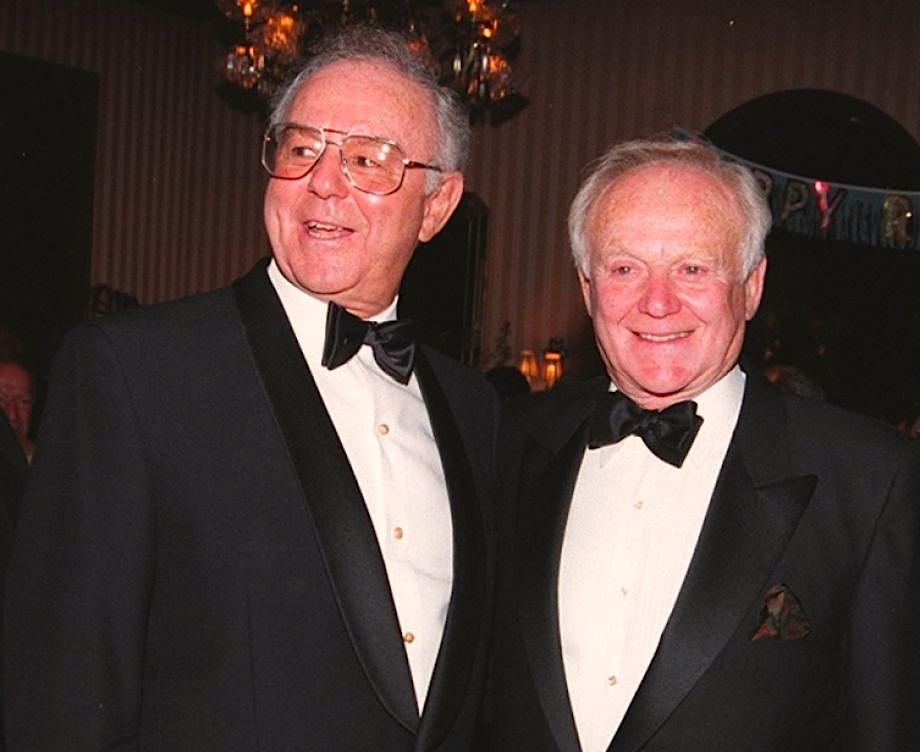 America,
at a time when San Francisco had no others of that
ilk to brag of. Ernie’s attracted all the big
names, from the local pols and sports figures to
everyone in the entertainment industry who knew
they would be treated not as celebrities but as
people who knew how to act with a genuine
sophistication that reflected itself throughout
the restaurant. Rarely
a day went by when columnist Herb Caen didn’t
mention who of note was dining at Ernie’s—perhaps
Sinatra, Monroe, or Streisand.
America,
at a time when San Francisco had no others of that
ilk to brag of. Ernie’s attracted all the big
names, from the local pols and sports figures to
everyone in the entertainment industry who knew
they would be treated not as celebrities but as
people who knew how to act with a genuine
sophistication that reflected itself throughout
the restaurant. Rarely
a day went by when columnist Herb Caen didn’t
mention who of note was dining at Ernie’s—perhaps
Sinatra, Monroe, or Streisand.
The walls were Barbary Coast deep red brocade,
there was an open fireplace, the staff wore
tuxedoes, and Victor and Roland were always on
hand to provide a buoyant bonhomie. The
place was opened in 1934 as Il Trovatore, in what
had once been a dance hall, by a cook named Ernie
Carlesso, who sold the business to his waiter, Ambrogio
Gotti. His
sons Victor and Roland worked as busboys but
eventually bought the restaurant, keeping the name
Ernie’s. Each year the Gottis improved the
premises and wine stock, which became one of the
stellar cellars in the country, and the
continental menu—tournedos Rossini, chateaubriand,
frogs’ legs Provençal--was always based on the
finest ingredients obtainable in northern
California.
There was tableside service and plenty of
flamed dishes.
After six decades the restaurant finally closed in
1995, not a victim of change so much as it was
just time for the party to end.
Of course, the most famous habitué of Ernie’s was
Alfred Hitchcock, who wanted to film parts of his
San Francisco-based 1958 movie 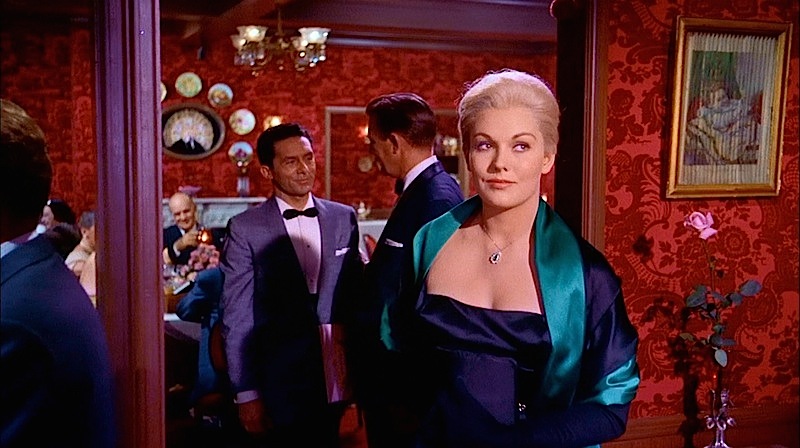 “Vertigo”
in the restaurant. But since the Gottis simply
could not shut down their business for endless
shoots, the director had to reproduce it as a set
(above, with James Stewart at
the far right), with every detail
faithful to how the bar and dining room looked.
“Vertigo”
in the restaurant. But since the Gottis simply
could not shut down their business for endless
shoots, the director had to reproduce it as a set
(above, with James Stewart at
the far right), with every detail
faithful to how the bar and dining room looked.
I will never forget seeing that movie years later,
while I was in college, watching James Stewart in
an impeccably cut dark suit, white shirt and
silver tie, escorting his fantasy lover Kim
Novak (left) through the dining room.
(I didn’t know at the time that the Gotti brothers
actually appeared in the movie—Victor said he
flubbed his line). To me in the slow tracking
shot of Stewart moving with the glowingly
beautiful Hitchcock blonde Kim Novak I saw
everything I someday wanted to achieve—membership
in a civilized, grown-up world where such moments
were possible and where good taste in dress,
manners, food and wine were requisite to the
pleasures of such an evening. In a
way, I think that scene set in Ernie’s, were early
nudges towards my career as a food and travel
writer.
As soon as I
could, on my first trip to San Francisco, I dined
at Ernie’s and for once, the glamour of the real
world exceeded even that of the movie version. I was
hooked. And
I was proud to have known that great gentleman
restaurateur Victor Gotti.
THAT ARE BETTER THAN EVER
By John Mariani
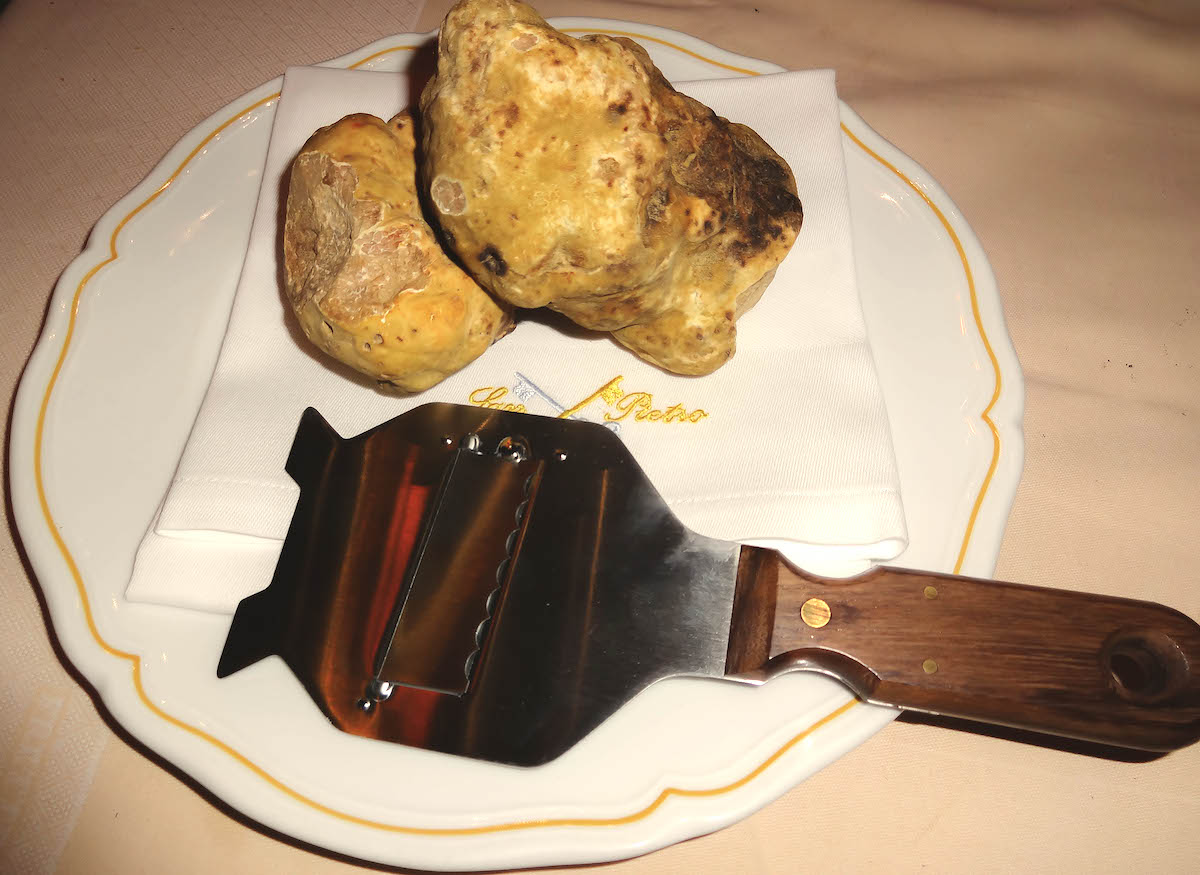
The white truffles at San Pietro
Yogi Berra once famously quipped of a
restaurant, “Nobody goes there anymore. It's
too crowded.”
Which is true of an amazing
range of New York restaurants that never make
the list of New York
magazine’s Restaurant
Power
Rankings--the “most-talked-about,
must-visit restaurants in New York City”--but
whose dining rooms are fully booked every day
and night they’re open.
Two veteran Italian restaurants easily fall into
this category of places that have a fiercely
loyal clientele and whose reputations bring
scores of
pre-theater and post-theater visitors.
Both are beautiful restaurants of high style,
the tables draped in good linens, the wine
glasses thin, the service staff pleasingly
dressed. The dedicated owners never take a
single guest for granted.
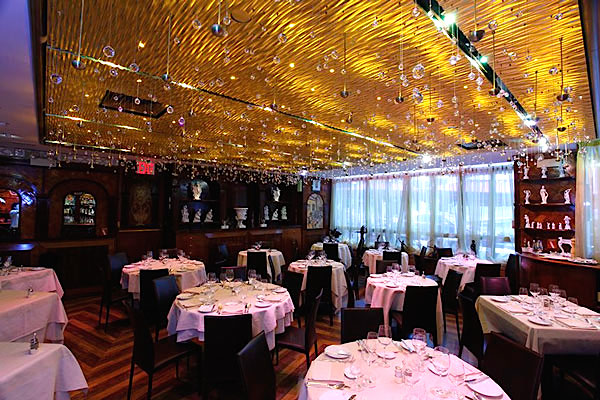 San
Pietro
San
Pietro
18 East 54th
Street
212-753-9015
sanpietrorestaurant.us
San
Pietro, just off
Fifth Avenue in Midtown, has for 22 years been
running as smoothly as an autostrada,
despite never having had a review by the NY Times. Yet
owner Gerardo Bruno does not have time
to complain, because he is hard at work at his
ristorante
every day, lunch and dinner, catering to a
crowd of business people and those in the arts
and fashion industry, who come here for
classic Italian cooking, especially that of
the Amalfi coast, whence Mr. Bruno comes.
You are received by a lovely hostess, behind
whom stands the impeccably dressed Mr. Bruno,
who smiles with surprise to see everyone,
whether it’s someone who dines there three times
a week or comes for the first time. On
the table inside the door are arrayed the
freshly arrived white truffles, the size of
tennis balls (above), and bottles of
wines he recommends. Most of his clientele ask
his advice.
White-jacketed waiters bring bread and olive oil
to the table the moment you sit down, and, after
taking your cocktail order, Mr. Bruno or a
captain will explain the night’s specials, which
always number about half a dozen, geared to the
season and the market. 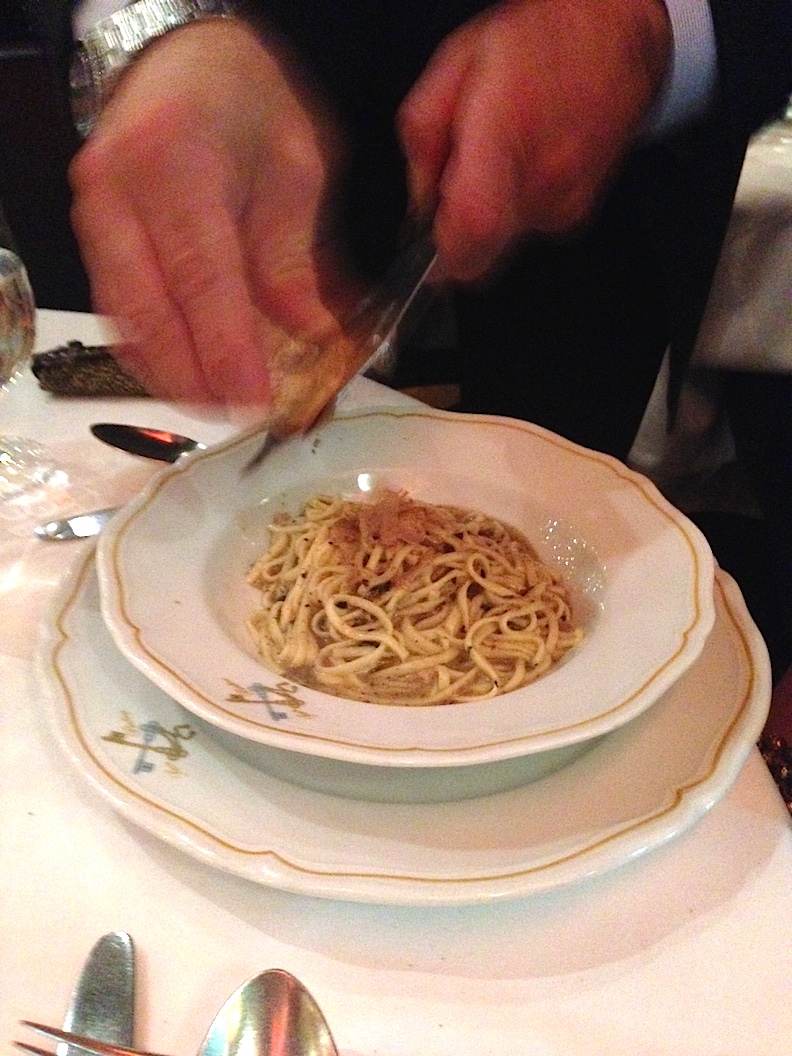 On my recent
visit, when my wife and I just wanted a night
out alone, we put ourselves in Mr. Bruno’s
hands—actually everyone calls him Gerardo—and
were rewarded with sumptuous food of the moment.
On my recent
visit, when my wife and I just wanted a night
out alone, we put ourselves in Mr. Bruno’s
hands—actually everyone calls him Gerardo—and
were rewarded with sumptuous food of the moment.
We began with a variation
on beef carpaccio, with paper-thin slices of
filet mignon quickly warmed under herbed sea
salt and served with arugula, fresh porcini mushrooms
and parmigiano
($32). An
“autumn salad” was artfully composed of white
and red radicchio, puntarelle
greens, juicy ripe pear, and shaved parmigiano,
dressed with very fine olive oil. Then came a
morsel of crispy potato and zucchini flowers
oozing melted Taleggio cheese.
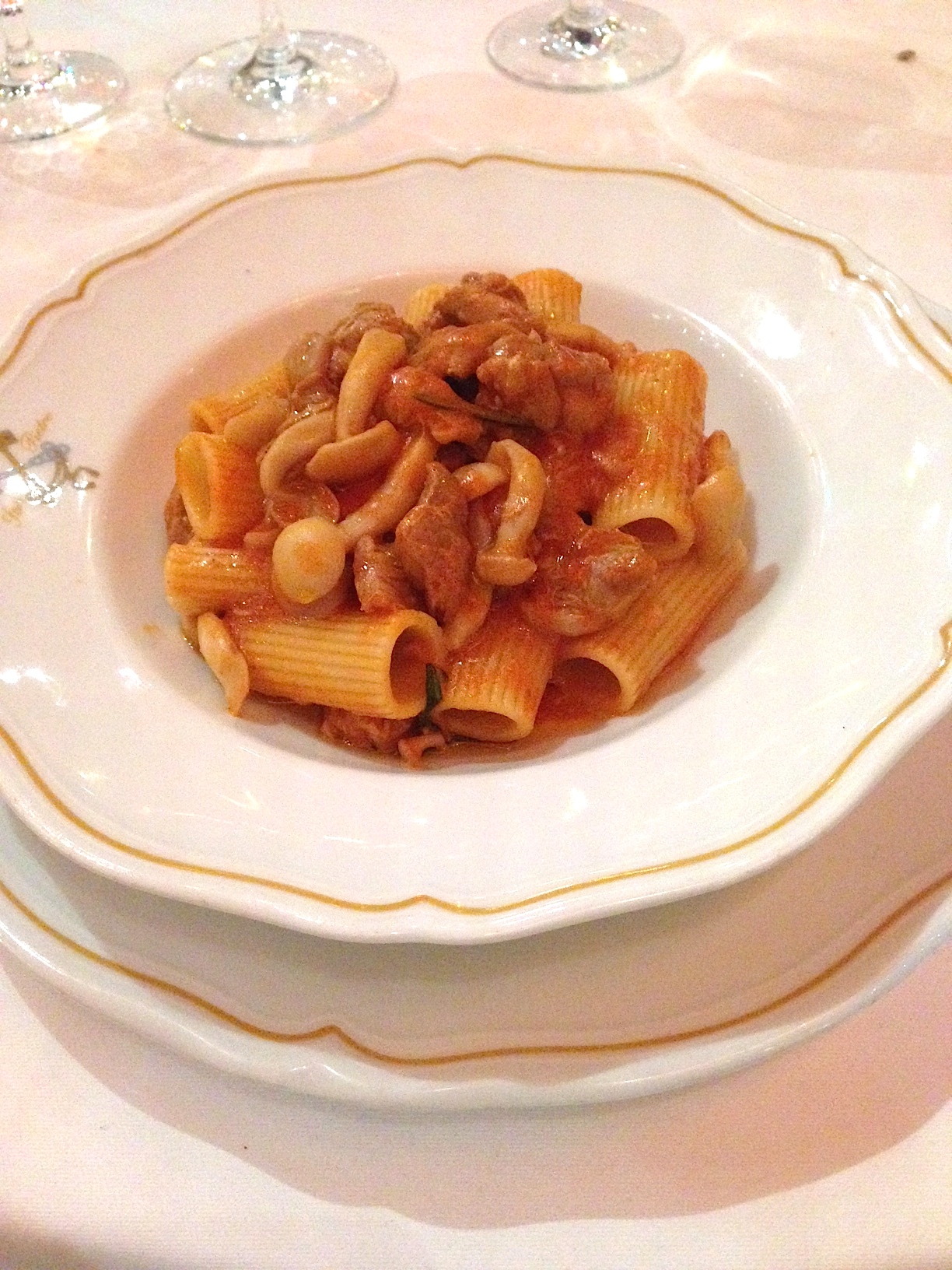 Those
fragrant white truffles were put to glorious use
over fresh egg-rich tagliolini
(market price)--the aroma carries across the
room--while a heartier pasta was al dente
rigatoni (below) with tomato, mushrooms
and veal ragù
($30).
Those
fragrant white truffles were put to glorious use
over fresh egg-rich tagliolini
(market price)--the aroma carries across the
room--while a heartier pasta was al dente
rigatoni (below) with tomato, mushrooms
and veal ragù
($30).
Our entrees were a hefty grilled Prime ribeye
steak with watercress and shaved parmigiano ($58),
and the
crispiest
roasted baby pork I’ve ever had--its
skin almost like bacon--with
herbs, crushed peppercorns, lemon and orange
scent, served with broccoli di rape and spicy
cherry peppers ($48).
Obviously, we were full, but San Pietro makes
splendid desserts, and the soft chocolate torta
is outstanding.
The huge wine list changes all the time, for
Gerardo is always on the look-out for delectable
new estate bottlings (his family also runs the
first-rate San
Pietro Wines & Spirits in Tuckahoe,
NY). Of
course, all of the big-gun labels are on there,
too.
San Pietro is open for lunch and dinner
Mon.-Sat.
CIRCO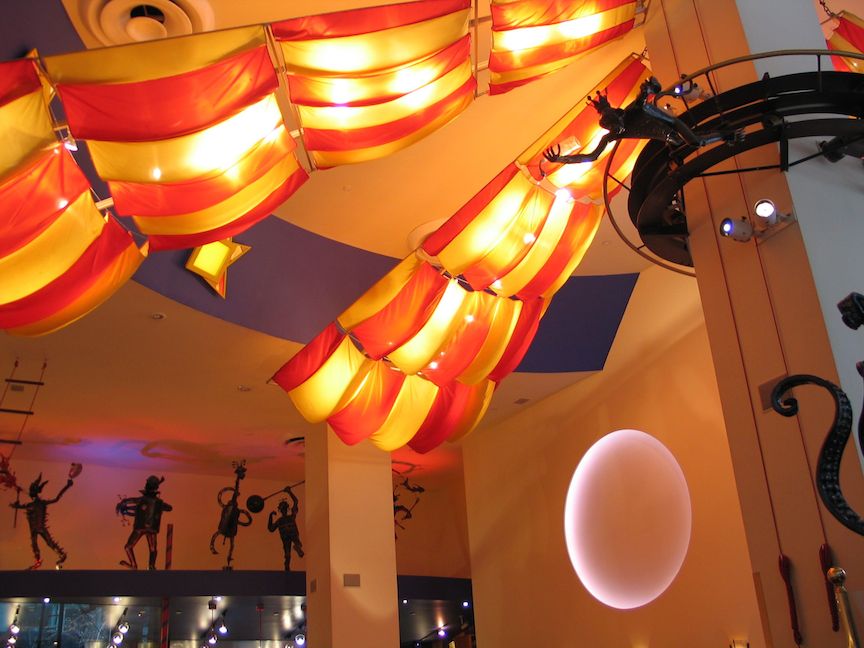
120
West 55th Street (near Avenue of
the Americas)
212-265-3636
circonyc.com
Circo
opened on West 55th Street near the
Hilton Hotel and Ziegfeld Theater
18 years ago, and the Maccioni family has always
kept it true to their Tuscan roots. Indeed,
many of the recipes are from the materfamilias,
Egidiana (below), who casts a withering
glance on any waiter or cook who has compromised
her food, putting her trust in executive chef
Alfio Longo, who hails from Pistoia. (The
Maccionis also run the illustrious Le Cirque
and the new Sirio
Ristorante in NYC, as well as others
around the world, with a brand new Circo
in Abu Dhabi.)
Up front stands one of the city’s finest maȋtre
d’s,
Bruno Dussin, a Venetian displaying half century
of experience, obvious from his dress, his
demeanor and his wit. On most nights there is
another of the Maccionis on hand—Marco, Mauro,
Mario, Egidiana, perhaps even the patriarch,
Sirio—to seal that extra sense of
professionalism that is definitively both very
Italian and very New York.
The high-ceiling décor by Adam Tihany is themed
to an Italian circus, with animal sculptures
cavorting along with commedia dell’arte figures
on circus tent motifs and rope ladders, with a
spotlight on one wall.
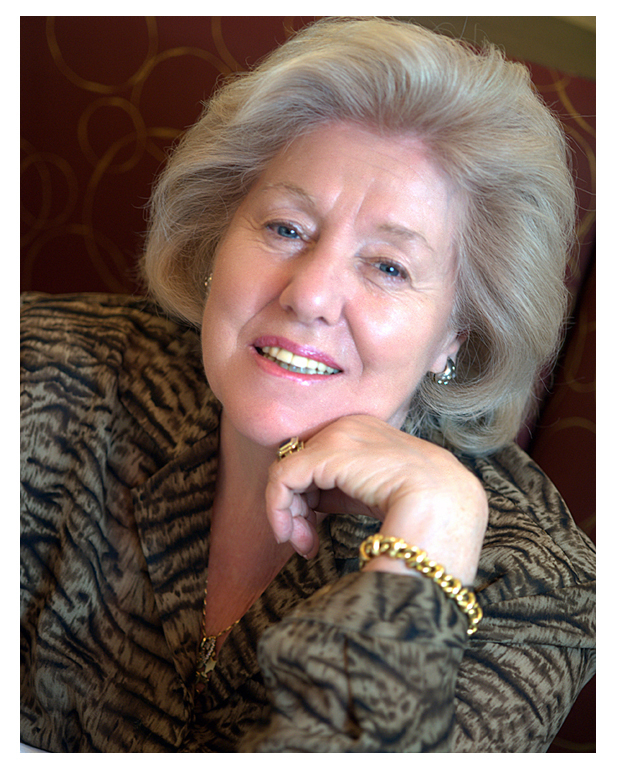 Circo’s menu
is larger than what one usually thinks of in a
trattoria, but all of it expresses the
Maccionis’ love and flair for cucina
rustica, beginning with La Signora’s
thirty-vegetable soup ($11), on the menu since
the beginning.
The buffalo mozzarella is the finest
imported variety available, the prosciutto from
Tuscany.
Circo’s menu
is larger than what one usually thinks of in a
trattoria, but all of it expresses the
Maccionis’ love and flair for cucina
rustica, beginning with La Signora’s
thirty-vegetable soup ($11), on the menu since
the beginning.
The buffalo mozzarella is the finest
imported variety available, the prosciutto from
Tuscany.
The fried
mixed seafood with zucchini, eggplant, lush
marinara sauce, spicy aïoli and aromatic herbs
($19) is textbook perfect, but my favorite
autumn dish is the soufflé of porcini mushrooms
with a rich parmigiano fondue and
truffles ($23).
There are five pizzas on the menu, which seems a
bit odd in a Tuscan restaurant, but they are
good, the crust on the thin side.
Pastas will always be the glory
of Italian cuisine, and Circo’s show the
enormous care the kitchen takes to marry texture
and flavor in every forkful. “Ravioli di
Mamma Egi” are filled with bufala ricotta and spinach,
then glossed with good butter and fresh sage
($23). Right now and
through New Year’s, there is tortelli with
butternut squash,
mustard fruit, saba wine
reduction, sage and a crumble of amaretti
cookies ($26). The tagliatelle
verde alla bolognese
($26) is one of the most authentic in the city,
while the risotto with radicchio and Taleggio
cooked slowly in amarone red wine ($26) is
outstanding. By the way, you may order two
pastas, as a main course, for $32.
You won’t find more lustrous, succulent Mediterranean sea bass
in salt crust or with grilled, roasted
vegetables ($37) than here, and the stuffed
lobster “Riviera” style (right) with tagliolini
carbonara ($44) is as sumptuous a dish
as any on the menu. They also do a true cacciucco
alla Livornese , a Tuscan fish soup of
prawns, calamari, octopus, monkfish, clams and
mussels ($34). It’s one of the few
Italian restaurants in America where I happily
order the seafood.
Among my favorite current main courses are the
braised cheeks of Colorado-raised wagyu beef
with a pumpkin puree, chestnuts, Tuscan kale and
a chianti classico sauce ($32). You’ll
come no closer in Manhattan to the classic bistecca
alla fiorentina ($43 per person) than the
thick, quickly seared example at Circo, sliced
in slabs, gorgeously rare inside.
David Gomez’s desserts stay fairly simple—an
excellent tiramisù and a very fine, sweet and
tangy apple tart with fior di
latte gelato. The Tuscan bomboloni donuts
with marmalade are a very good item to share at
meal’s end with a well-made espresso.
The 400-label wine list is one of the best in
the city for Italian bottlings, and there are
plenty of wines under $50.
Circo is open Mon.-Fri. for lunch, nightly for
dinner. The fixed price lunch is $28, at
dinner $48. $42 pre-theater
❖❖❖
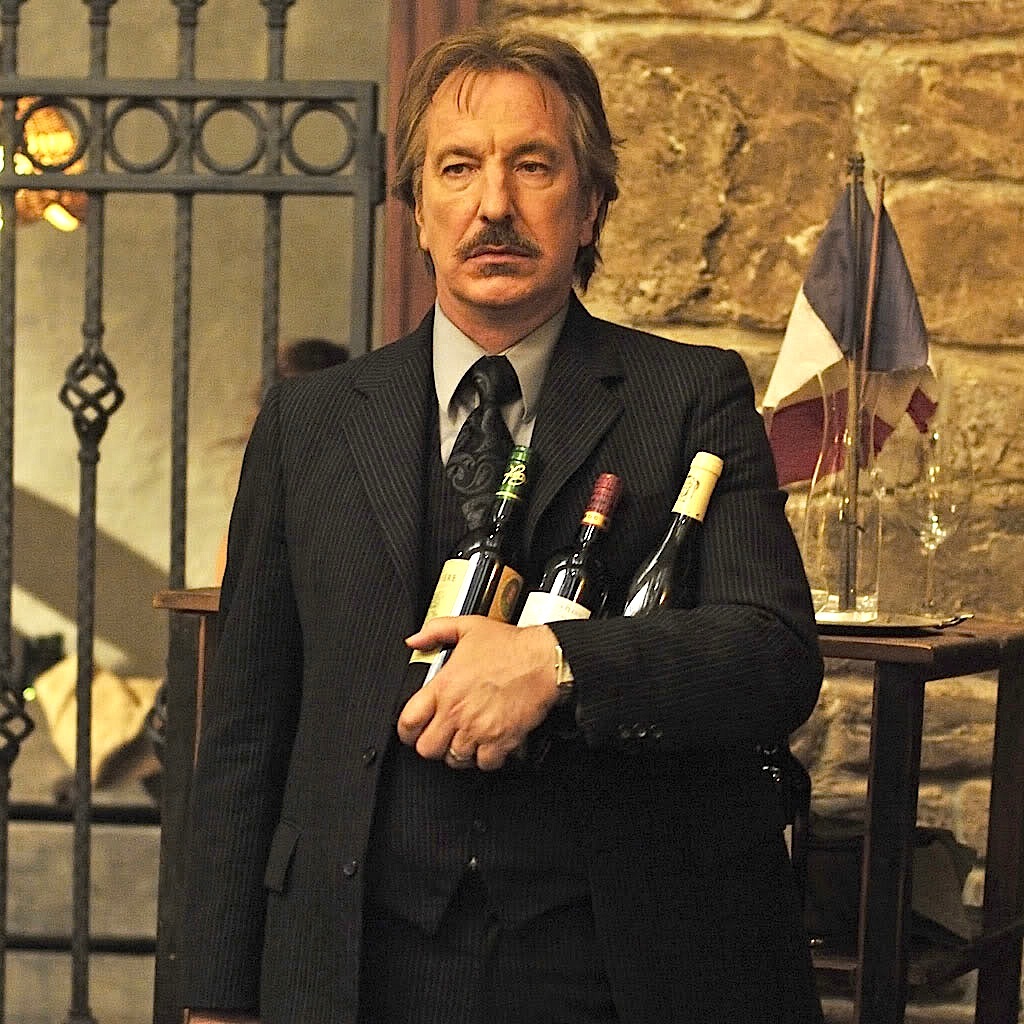 WHAT I'M
DRINKING NOW
WHAT I'M
DRINKING NOWBy John Mariani
With
autumn
in full and chilly swing, I don’t much
change the heft of the wines I drink as I
do tilt towards more varietals, depending
on what I’m eating. Here
are some I’ve been particularly delighted
with over the past few weeks.
Quintodecimo
Giallo
d’Arles 2013
($48)--This Campanian white wine producer from
outside Naples makes this superb Greco di Tufo
DOCG--a local varietal whose popularity has made
for some mediocre exports. Quintodecimo’s shows
far more structure and complexity, color and
intensity than most. The name pays homage to the
color of golden yellow preferred by Von Gogh
during his time in Arles. A very
good wine with grilled seafood or a zuppa di
pesce.
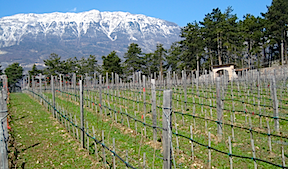 it undergoes
élévage for about 18 months in 100% French oak and
rests for a year before release. The result is a
soft, nuanced wine with its own Italian, not
French, character.
Right now it is ready to drink with a fine
roast chicken.
it undergoes
élévage for about 18 months in 100% French oak and
rests for a year before release. The result is a
soft, nuanced wine with its own Italian, not
French, character.
Right now it is ready to drink with a fine
roast chicken.
Beronia Rioja 2010
($16)--This “limited edition” made to
celebrate this Spanish estate’s 40th
anniversary is made from tempranillo, mazuelo and graciano
grapes harvested from its oldest vineyards. At 14%
alcohol it shows the power of the tempranillo
varietal, with all its almond-like, rustic flavors
and long finish, ideal with roast lamb on the
grill.
Franciscan
Estate
Magnificat 2010 ($50)--At 14.5%
alcohol, this Meritage-style blend of 78% cabernet
sauvignon, 18% merlot and 4% petit verdot is
blended, says the label, like the vinous
equivalent of Bach’s 1733 “Magnificat in D Major.” That’s
fair enough, for this splendid, rich, very
California-style cab shows levels of flavor like
those of the five soloists in the musical piece.
There’s spice entwined with plum notes and tannin,
and it’s loosening up just fine right now,
excellent with prime rib of beef and Yorkshire
pudding for the holidays.
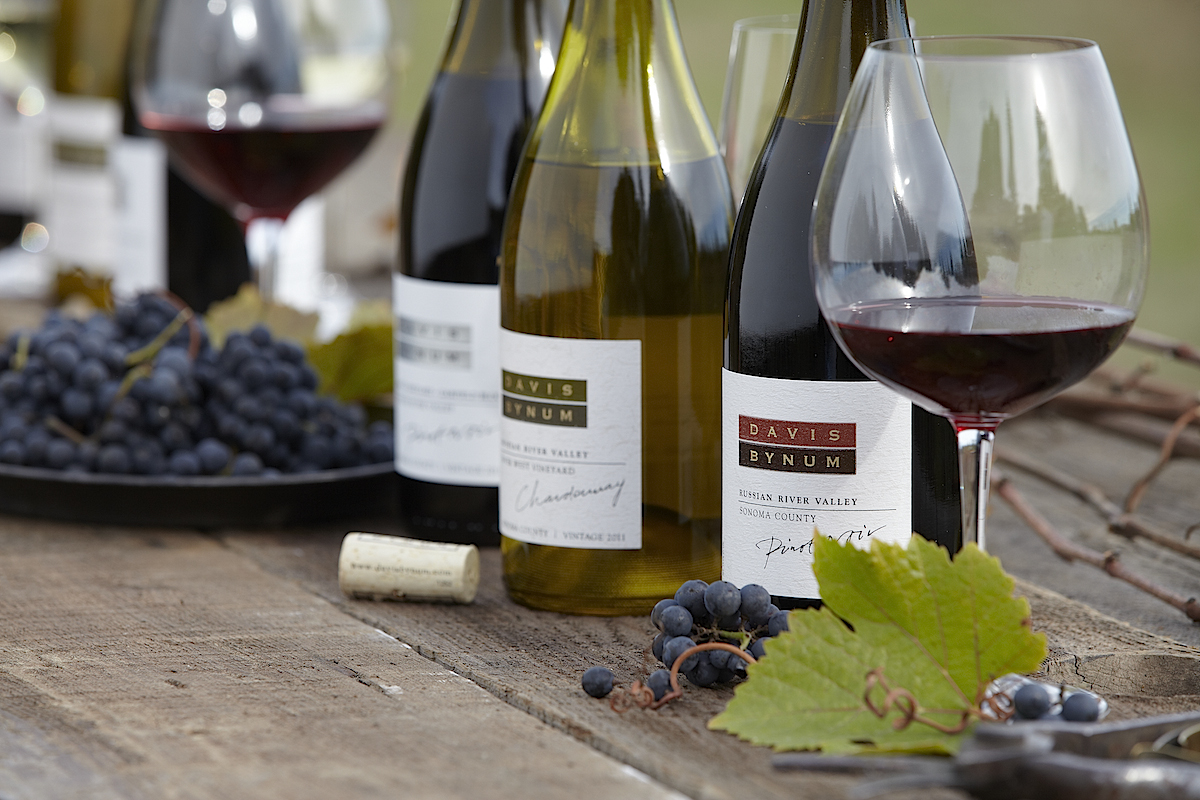 Davis Bynum
Dijon Clone 667 Jane’s Vineyard Pinot Noir 2012
($55)--I am as loud a critic of Sonoma Valley’s
overripe pinot noirs as I am a booster of its
well-made, stylish examples like this rich, well
balanced example at 14.5% alcohol. Bynum (now
owned by Rodney Strong Vineyards) has long
championed more refined pinot noirs, and the acid
so often lacking in New World pinots is here with
subtlety and charm, making this perfect for roast
duck or goose.
Despite its youthfulness, it’s a pretty
wine right now.
Davis Bynum
Dijon Clone 667 Jane’s Vineyard Pinot Noir 2012
($55)--I am as loud a critic of Sonoma Valley’s
overripe pinot noirs as I am a booster of its
well-made, stylish examples like this rich, well
balanced example at 14.5% alcohol. Bynum (now
owned by Rodney Strong Vineyards) has long
championed more refined pinot noirs, and the acid
so often lacking in New World pinots is here with
subtlety and charm, making this perfect for roast
duck or goose.
Despite its youthfulness, it’s a pretty
wine right now.
Tenuta
Santa
Maria alla Pieve Decima Aurea 2007 ($33)--Red
wines from Veneto, with the exception of amarones,
don’t get much attention because they tend to be
fairly lightweight, like bardolino and
valpolicella, and attempts at using Bordeaux
varietals like merlot have been largely
unimpressive.
But this merlot, from Gaetano Bertani, is
outstanding, telescopic in its flavors as it
travels over the palate to a lasting finish. Seven
years of age shows all the mellowness merlot has
at its best, and this is certainly comparable to a
very fine St. Émilion or Pomerol. Drink
with roast pork and apples.
Cable Bay
SyrahWaiheke Island 2012
($30)--Founded in 1998 on one of the loveliest
islands in New Zealand, Cable Bay grows ten
different varietals, including an award-winning
chardonnay. I was enchanted with this
full-bodied but stylish syrah (with 2 percent
viognier), which at 14% alcohol proves that New
Zealand can make syrahs with elegance and
finesse, not blockbusting overripeness. It's a
young bottling but delicious when I drank it; a
year or two more of age will probably improve it
further.
Underwood
Pinot
Gris 2013 ($6)--Pinot gris (the same
as pinot grigio) has been so overproduced and
oversupplied that its reputation is deservedly low. Then
along comes a screw-topped surprise out of Oregon
from a small company called Union Wine. It’s
not a great white wine by a long shot, but it’s
fruited without being cloyingly sweet, shows good
acid, and—believe it or not—you can buy it in 375
ml aluminum cans! Slosh it down as an aperitif or
with a bowl of pasta with butter and sage.
deservedly low. Then
along comes a screw-topped surprise out of Oregon
from a small company called Union Wine. It’s
not a great white wine by a long shot, but it’s
fruited without being cloyingly sweet, shows good
acid, and—believe it or not—you can buy it in 375
ml aluminum cans! Slosh it down as an aperitif or
with a bowl of pasta with butter and sage.
Domaine
Fournier
Sancerre Cuvée Silex 2012 ($35)--Sancerre
is my favorite go-to white wine as an
aperitif-and-first course choice, and Domaine
Fournier's Silex is my favorite Sancerre.
While it shows its Loire Valley appellation
proudly, it is the specific terroir that comes
across as highly individualistic. The fermentation
lasts three weeks, with no malolactioc, and the
acid-mineral ratio is just perfect. I think it's
the ideal expression of sauvignon blanc, and at
$35, it's really a bargain.
❖❖❖
 HA! JESUS
DIDN'T EVEN PAY
HA! JESUS
DIDN'T EVEN PAY
THE
BILL FOR THE LAST SUPPER!
PUT THIS PLACE
ON SPEED DIAL!
"Even
the staff uniforms are artful: boys in matelot
stripes straight from a Jean Paul Gaultier
homoerotic ad, or wet-dream mechanics in boiler
suits. Every now and then, a tiny person dressed as
a French maid pops up, her sole role apparently to
sweep the floors – a truly sisyphean task. This
might be the most absurd restaurant in the UK, a
Barbie-on-MDMA fantasy serving unintelligible food
at prices to make your eyes water into matching
pinkness. The bill comes in a sandpaper envelope; it
might as well just say, “Ouch!” You’d probably hate
it. Me? Well, darlings, I think it’s faahbulous. And
hey, it’s art."--Marina O’Loughlin, "David Shrigley at Sketch," The Guardian (Oct.
24).
❖❖❖

TURKEY
DAY TURNAROUND
by Cristina Mariani-May
co-CEO of Banfi
Vintners America's leading wine
importer
Now I know
that seems like a contradiction, but follow me on
this. Let’s
take as an example something else near and dear to all
gourmets, virtual or otherwise: the tomato. It is
native to the Americas; the conquistadors brought it
to Spain in the 1500s and the royal Bourbon chefs
brought it to the “Kingdom of Naples” in the 1600s. Yet when we
think of tomato based dishes, including sauces and
salads, we think Italian. So in essence the tomato has
become Italian, but its roots – and its inspiration –
are thoroughly American.
Now take the case of wine, or at
least one particular wine estate and its very American
story. My
grandfather, John Mariani Sr., 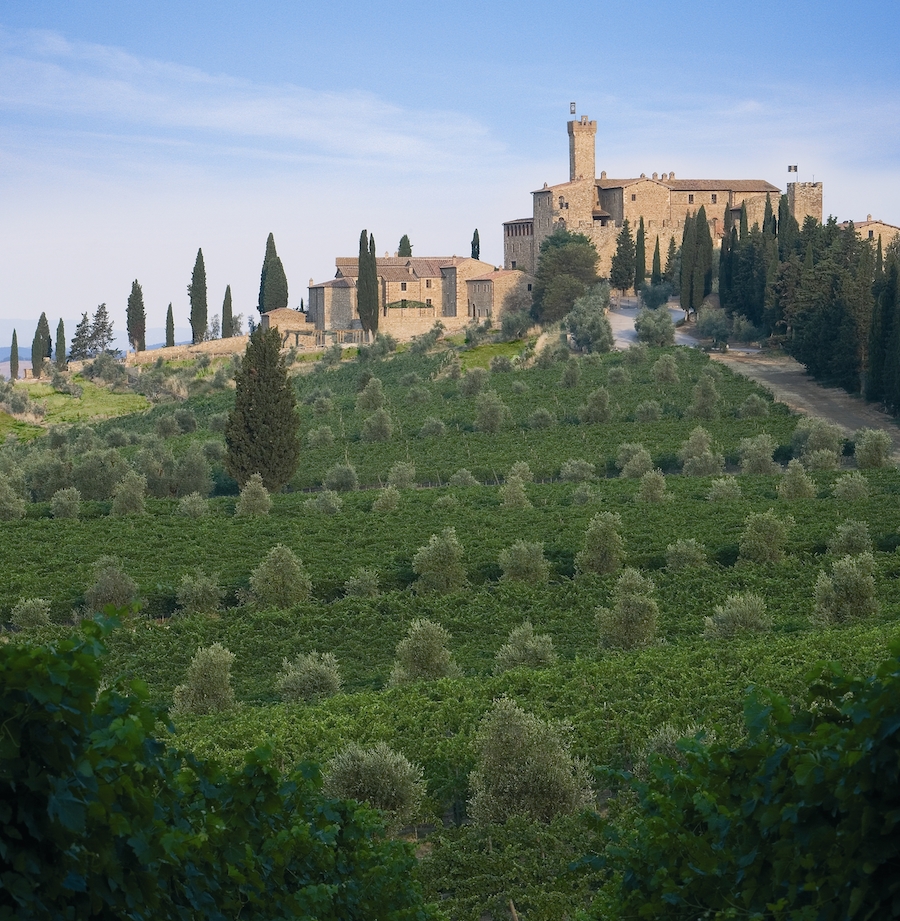 was an
all-American boy, born in Torrington, CT to a
successful Italian immigrant family. As a young
boy, he returned to his roots to study in Italy under
the tutelage of his maiden aunt, Teodolinda Banfi,
head of household for Achille Ratti; Ratti was the
archbishop of Milan and both he and Teodolinda later
did their own immigration of sorts to Vatican City
when he was elected Pope Pius XI, but that’s a story
for another time.
was an
all-American boy, born in Torrington, CT to a
successful Italian immigrant family. As a young
boy, he returned to his roots to study in Italy under
the tutelage of his maiden aunt, Teodolinda Banfi,
head of household for Achille Ratti; Ratti was the
archbishop of Milan and both he and Teodolinda later
did their own immigration of sorts to Vatican City
when he was elected Pope Pius XI, but that’s a story
for another time.
My grandfather finished his studies
and returned to the US in order to serve his country
as it entered World War I. After the war he settled in New
York to found a wine importing business, taking
advantage of the new peace and prosperity as well as
some of his old world contacts. He raised
his children well and sent them to Ivy League schools
so they were well equipped to take over the family
business. His
sons John, Jr. (my
father, who also served in the US military) and Harry
built the import trade up significantly; while always
remembering their roots, they embraced the American
ideal of self improvement. When Italian wines did not meet
up to their standards (or, more importantly, the
standards of their customers and the critics of the
wine world), they took matters into their own hands, a
very American move but with great Italian sensitivity.
They put together an estate in an
ideal spot in Tuscany, planted vines, built a winery
and developed a label – all from scratch so as not to
inherit anybody else’s mistakes. They set
new standards and quickly raised the bar for Italy and
the broader world of fine wine with their
accomplishments at Castello Banfi (right).
You can learn more about this great
American story from our website, www.castellobanfi.com,
but in the meantime you should celebrate American
opportunity and inspiration by enjoying Castello Banfi
wines with your Thanksgiving feast. I can think
of nothing more quintessentially American than that.
Here are my personal top dozen
Banfi wines for the Thanksgiving feast:
La Pettegola – A bright, zesty wine from the
Tuscan coast with clean fruit flavor and zippy
acidity to welcome guests and kick off the
festivities. 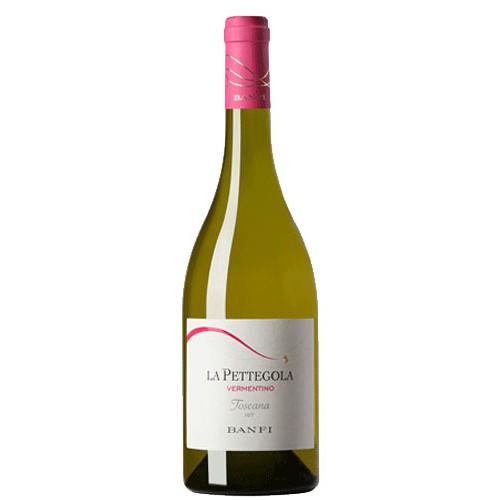 This delightfully well structured wine
also has the character to follow through with the
varied and complex flavors at the table.
This delightfully well structured wine
also has the character to follow through with the
varied and complex flavors at the table.
Principessa Gavia Gavi – From a single vineyard
property in southern Piedmont, not far from the
border of coastal Liguria. Made from 100% Cortese grapes,
this charming wine has intriguing crispness
which exalts the fruitiness of this historic and
noble wine. Named for an ancient noble woman, this
wine is very lady like indeed, showing surprising
nuances with each encounter and pairing.
Centine Bianco – A wine that, like most
Italians, wears it heart on its sleeve – the fresh,
grassy aroma belies the Sauvignon Blanc portion of
this blend; smooth flavors of stone fruit such as
peaches and apricots highlight the character of
unoaked Tuscan Chardonnay, and it all closes with
the crisp, clean, almond like finish that is the
signature of Tuscan Pinot Grigio.
Fontanelle Chardonnay – A more fruit-forward, fuller
bodied and lush wine.
Fresh and harmonious with hints of apple,
peach and apricot. Its balanced complexity is
endowed in part from a small portion of the wine
that is subtly fermented and aged in oak barrels.
Unfiltered.
Centine Rosé - A Delightful pink rosé with
hints of woodland berries and a long, crisp finish. Made from
the same grapes as its sister red wine – Tuscany’s
native Sangiovese dominates with supporting roles by
Cabernet and Merlot.
L’Ardí Dolcetto d’Acqui – A lively and quaffable red
wine made from Dolcetto grapes from Piedmont. Ruby
colored and redolent of fresh grapes and ripe
cherries, with a dry finish.
Centine - A Super Tuscan blend of
Sangiovese, Cabernet Sauvignon and Merlot vinified
in a firm, round style that easily accompanies a
wide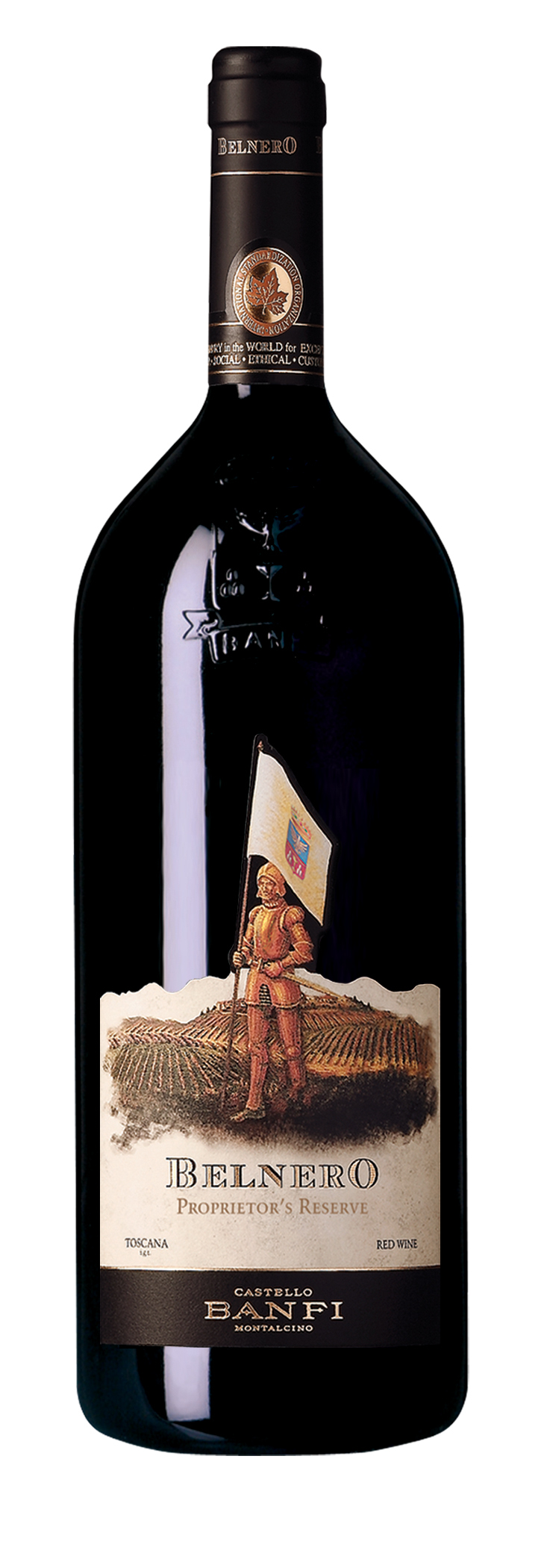 range of dishes. A smooth and
fragrantly satisfying wine with international
character.
range of dishes. A smooth and
fragrantly satisfying wine with international
character.
BelnerO – A Sangiovese dominant wine
that speaks eloquently with a sense of the place
that is Montalcino.
Round, generous and deeply flavored, with
zesty character that will make you thankful for its
presence at the table.
Cum Laude – A complex and elegant red
which graduated “With Honors,” characterized by
aromas of juicy berries and fresh spices. This
wine, as its name implies, makes a bold statement,
but its soft tannins will not dominate or overwhelm
the meal.
Poggio alle Mura Brunello di
Montalcino – The tangible result of years
of intensive clonal research on Montalcino’s native
Sangiovese grape.
Estate bottled from the vineyards surrounding
the medieval Castello from which it takes its name. Seductive,
silky and smoky.
Deep ruby in color with an expressive bouquet
of violets, fruits and berries as well as cigar box,
cedar and exotic spices.
SummuS – A wine of towering elegance,
SummuS is an extraordinary blend of Sangiovese which
contributes body; Cabernet Sauvignon for fruit and
structure; and Syrah for elegance, character and a
fruity bouquet.
A deep, complex red wine with layers of
flavor that continue to reveal themselves in a long
finish.
Rosa Regale - Aromatic with a hint of rose
petals and raspberries, a unique sparkling ruby-red
wine – great with savories and especially well
suited to desserts, particularly chocolate. It is
also delightful and festive icebreaker, and because
the traditional Thanksgiving feast has such a broad
range of flavors, Rosa Regale can keep charming
company throughout the meal. Also
available in romantic 375ml half bottles, 187ml
single serving or the 1.5L magnum for more generous
sharing.
 I'm proud and happy to
announce that my new book, The
Hound in Heaven (21st Century Lion Books),
has just been published through Amazon
and Kindle. It is a Christmas novella, and
for anyone who loves dogs, Christmas, romance,
inspiration, even the supernatural, I hope you'll find
this to be a treasured favorite. The story
concerns how, after a New England teacher, his wife
and their two daughters adopt a stray puppy found in
their barn in northern Maine, their lives seem full of
promise. But when tragedy strikes, their wonderful dog
Lazarus and the spirit of Christmas are the only
things that may bring his master back from the edge of
despair. WATCH
THE VIDEO
I'm proud and happy to
announce that my new book, The
Hound in Heaven (21st Century Lion Books),
has just been published through Amazon
and Kindle. It is a Christmas novella, and
for anyone who loves dogs, Christmas, romance,
inspiration, even the supernatural, I hope you'll find
this to be a treasured favorite. The story
concerns how, after a New England teacher, his wife
and their two daughters adopt a stray puppy found in
their barn in northern Maine, their lives seem full of
promise. But when tragedy strikes, their wonderful dog
Lazarus and the spirit of Christmas are the only
things that may bring his master back from the edge of
despair. WATCH
THE VIDEO
“What a huge surprise turn this story took! I was
completely stunned! I truly enjoyed this book and its
message.” – Actress Ali MacGraw
“He had me at Page One. The amount of heart, human
insight, soul searching, and deft literary strength that
John Mariani pours into this airtight novella is
vertigo-inducing. Perhaps ‘wow’ would be the best
comment.” – James Dalessandro, author of Bohemian
Heart and 1906.
“John Mariani’s Hound in Heaven starts with a
well-painted portrayal of an American family, along with
the requisite dog. A surprise event flips the action of
the novel and captures us for a voyage leading to a
hopeful and heart-warming message. A page turning, one
sitting read, it’s the perfect antidote for the winter
and promotion of holiday celebration.” – Ann Pearlman,
author of The Christmas Cookie Club and A
Gift for my Sister.
“John Mariani’s concise, achingly beautiful novella
pulls a literary rabbit out of a hat – a mash-up of the
cosmic and the intimate, the tragic and the
heart-warming – a Christmas tale for all ages, and all
faiths. Read it to your children, read it to yourself…
but read it. Early and often. Highly recommended.” – Jay
Bonansinga, New York Times bestselling author of
Pinkerton’s War, The Sinking of The Eastland, and
The Walking Dead: The Road To Woodbury.
“Amazing things happen when you open your heart to an
animal. The Hound in Heaven delivers a powerful
story of healing that is forged in the spiritual
relationship between a man and his best friend. The book
brings a message of hope that can enrich our images of
family, love, and loss.” – Dr. Barbara Royal, author of
The Royal Treatment.
Any of John Mariani's
books below may be ordered from amazon.com.
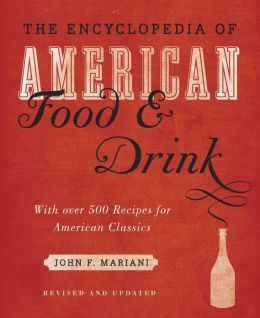 |
The Encyclopedia of American Food and Drink by John F. Mariani (Bloomsbury USA, $35) Modesty forbids me to praise my own new book, but let me proudly say that it is an extensive revision of the 4th edition that appeared more than a decade ago, before locavores, molecular cuisine, modernist cuisine, the Food Network and so much more, now included. Word origins have been completely updated, as have per capita consumption and production stats. Most important, for the first time since publication in the 1980s, the book includes more than 100 biographies of Americans who have changed the way we cook, eat and drink -- from Fannie Farmer and Julia Child to Robert Mondavi and Thomas Keller. "This book is amazing! It has entries for everything from `abalone' to `zwieback,' plus more than 500 recipes for classic American dishes and drinks."--Devra First, The Boston Globe. "Much needed in any kitchen library."--Bon Appetit. |
"Eating Italian will never be the same after reading John Mariani's entertaining and savory gastronomical history of the cuisine of Italy and how it won over appetites worldwide. . . . This book is such a tasteful narrative that it will literally make you hungry for Italian food and arouse your appetite for gastronomical history."--Don Oldenburg, USA Today. "Italian
restaurants--some good, some glitzy--far
outnumber their French rivals. Many of
these establishments are zestfully described
in How Italian Food Conquered the World, an
entertaining and fact-filled chronicle by
food-and-wine correspondent John F.
Mariani."--Aram Bakshian Jr., Wall Street
Journal.
"Equal parts
history, sociology, gastronomy, and just
plain fun, How Italian Food Conquered the
World tells the captivating and delicious
story of the (let's face it) everybody's
favorite cuisine with clarity, verve and
more than one surprise."--Colman Andrews,
editorial director of The Daily
Meal.com. "A fantastic and fascinating
read, covering everything from the influence
of Venice's spice trade to the impact of
Italian immigrants in America and the
evolution of alta cucina. This book will
serve as a terrific resource to anyone
interested in the real story of Italian
food."--Mary Ann Esposito, host of PBS-TV's
Ciao
Italia. "John Mariani has written the
definitive history of how Italians won their
way into our hearts, minds, and
stomachs. It's a story of pleasure over
pomp and taste over technique."--Danny Meyer,
owner of NYC restaurants Union Square
Cafe, The Modern, and Maialino.
|
 |
 |
 |
 |
 |
 |
 |
 |
 Everett Potter's Travel Report:
Everett Potter's Travel Report: 
 Eating Las Vegas
is the new on-line site for Virtual Gourmet
contributor John A. Curtas., who since 1995
has been commenting on the Las Vegas food
scene and reviewing restaurants for Nevada
Public Radio. He is also the
restaurant critic for KLAS TV, Channel 8 in
Las Vegas, and his past reviews can be
accessed at KNPR.org.
Click on the logo below to go directly to
his site.
Eating Las Vegas
is the new on-line site for Virtual Gourmet
contributor John A. Curtas., who since 1995
has been commenting on the Las Vegas food
scene and reviewing restaurants for Nevada
Public Radio. He is also the
restaurant critic for KLAS TV, Channel 8 in
Las Vegas, and his past reviews can be
accessed at KNPR.org.
Click on the logo below to go directly to
his site.

Tennis Resorts Online: A Critical Guide to the World's Best Tennis Resorts and Tennis Camps, published by ROGER COX, who has spent more than two decades writing about tennis travel, including a 17-year stretch for Tennis magazine. He has also written for Arthur Frommer's Budget Travel, New York Magazine, Travel & Leisure, Esquire, Money, USTA Magazine, Men's Journal, and The Robb Report. He has authored two books-The World's Best Tennis Vacations (Stephen Greene Press/Viking Penguin, 1990) and The Best Places to Stay in the Rockies (Houghton Mifflin, 1992 & 1994), and the Melbourne (Australia) chapter to the Wall Street Journal Business Guide to Cities of the Pacific Rim (Fodor's Travel Guides, 1991).


MARIANI'S VIRTUAL GOURMET
NEWSLETTER is published weekly. Editor/Publisher: John
Mariani.
Editor: Walter Bagley. Contributing Writers: Christopher Mariani,
Robert Mariani, Misha
Mariani,
John A. Curtas, Edward Brivio, Mort Hochstein,
Andrew Chalk, Dotty Griffith and Brian Freedman. Contributing
Photographers: Galina Dargery, Bobby
Pirillo. Technical Advisor: Gerry McLoughlin.
To un-subscribe from this newsletter,click here.
© copyright John Mariani 2014
